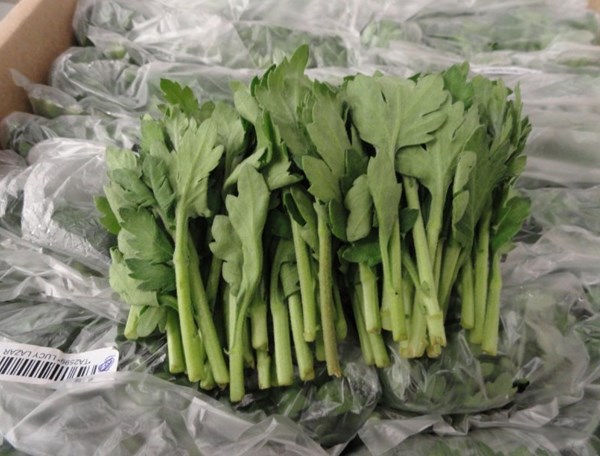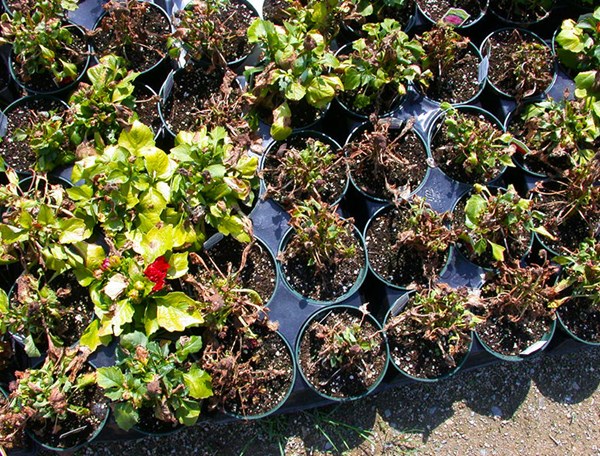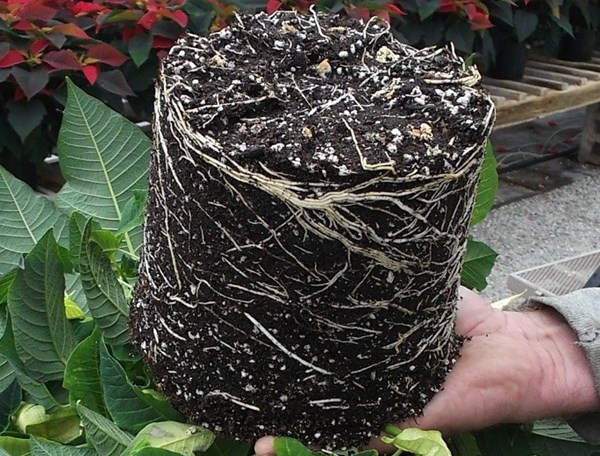Training Center
Root Disease Profile: Phytophthora
Thursday, September 7, 2023 | Troy Buechel
 Pathogens are always present in the greenhouse and are a continuous challenge for growers. The combination of plant material, moisture and certain environmental conditions can favour plant root diseases. In some cases, high fertilizer levels predispose plants to pathogenic fungi attack. This is especially true for plants with longer growth cycles, which remain in the greenhouse a long time.
Pathogens are always present in the greenhouse and are a continuous challenge for growers. The combination of plant material, moisture and certain environmental conditions can favour plant root diseases. In some cases, high fertilizer levels predispose plants to pathogenic fungi attack. This is especially true for plants with longer growth cycles, which remain in the greenhouse a long time.
Root diseases caused by Phytophthora can lead to considerable losses in crops, increased fungicide drench applications and reduced crop quality. It can attack a wide range of plants from herbaceous crops to woody ornamentals. The best way to keep it from infecting your crops is by preventing its entrance.
What are the symptoms of the Phytophthora root disease?
Plant roots infected by Phytophthora will show symptoms of wilting. If so, knock the plant out of the container and check the roots. Healthy roots are generally white and firm, whereas roots decaying from Phytophthora infection may appear water-soaked and have brownish coloring (Figure 1). Checking the root system can be a good way of seeing the disease before it’s too advanced to control.
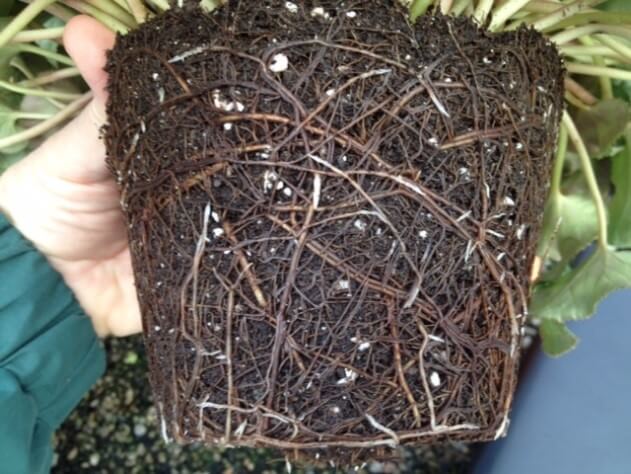
Figure 1. Phytophthora root rot disease of cyclamen. Source: Premier Tech.
Phytophthora overwinters primarily in infected plant roots or stems and only to a small extent will it occur in the soil without plant debris. The fungus can be splash-dispersed during heavy rains or overhead irrigation. It can be carried in run-off from plant to plant in the field (Figure 2) or from an infected plant to the drain holes of containers of nearby healthy plants, particularly if containers share puddles of water for an extended period on a floor or flood bench. Phytophthora can also be introduced through recycled water or from retention ponds.
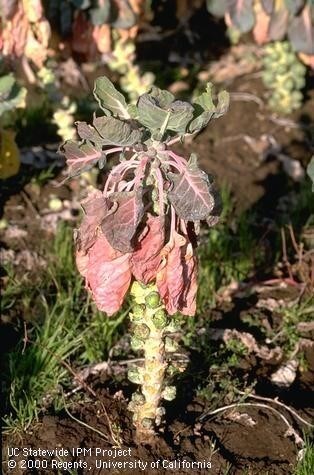
Figure 2. Purpling and reddening of older leaves is a symptom of Phytophthora root rot. Photo Credit: Jack Kelly Clark.
How to know if Phytophthora is the disease in your crop?
Phytophthora is a fungal organism that is like a water mold, like Pythium, but it’s more pathogenic. Fortunately, it’s not encountered frequently in greenhouse crops. This pathogen causes root and crown rot as well as foliar blighting. Environmental conditions that are conducive to this disease are similar to those for Pythium and include excess moisture and excess nitrogen fertility. Infection can occur over a wide range of temperatures: 15°C (59°F) to 28°C (82°F); however, 22°C (71°F) is optimum.
Soil moisture just below saturation is conducive to spore formation in 4-8 hours and they have motile zoospores that can be released in 10-60 min. Therefore, poorly drained or wet soil favors the pathogen. Zoospores infect feeder roots just behind the root cap.
Phytophthora sp. are host specific and are generally introduced through plant material. Prevention is the key to managing phytophthora because it is difficult to suppress with fungicides. There are specific fungicides for Phytophthora, but most broad-spectrum chemicals have limited control over this disease.
Prevention
- Select a growing medium that is ideal for the environment in the greenhouse. For a fall crop, when evapo-transpiration is low due to high relative humidity, it’s recommended to use a high porosity growing medium, like PRO-MIX HP. PRO-MIX HP is available with active ingredients like MYCORRHIZAE, a natural fungus to help acquire plant nutrients and promote root development, and/or BIOFUNGICIDE*, a natural bacterium to help suppress root disease. These microorganisms help reduce plant disease outbreaks by improving overall plant health, even though the BIOFUNGICIDE* is not labelled for the suppression of Phytophthora.
- Air temperature and ventilation inside the greenhouse must be ideal for the crop and the changing climate outside must be considered to minimize condensation and high humidity in the greenhouse. High humidity leads to slow dry-out of the growing medium, overwatering and increased plant susceptibility to Phytophthora outbreaks.
- If there is an apparent disease, it must be diagnosed by an independent laboratory so the appropriate fungicide that controls that root pathogen can be applied.
*All BIOFUNGICIDE products are available under BIOSTIMULANT in Canada and in Latin America.
If you suspect or want to be sure that the plants you have received are free of Phytophthora, send a sample of in-use growing medium and/or plant with an intact root system to a laboratory that tests for pathology. Many labs do a DNA scan to determine if a root rot pathogen is Phytophthora or another pathogen.
For more information and to know which labs offer this service, contact your Premier Tech Grower Services Representative:
 |
 |
 |
 |
|---|---|---|---|
|
Ed Bloodnick |
Nathan Wallace-Springer |
Lance Lawson |
Victor Brantly |
 |
 |
 |
|
|
Troy Buechel |
Susan Parent |
Jose Chen Lopez |
PRO-MIX® is a registered trademark of PREMIER HORTICULTURE Ltd.
Related Articles
-
Tips on Fertilizing Mums with Water Soluble Fertilizer
Young plants and flowering mums require lower fertilizer application rates (due to slower growth rates), while mums that are actively growing require higher fertilizer application rates.
-
Preventing Root Diseases: Pre-Planting, Planting and Post-Planting Tips
Root diseases can lead to considerable losses in crops, increased fungicide applications and reduced crop quality. There are several useful tips that, when followed, will help improve the growing environment to reduce potential root disease outbreaks.
-
The process of respiration in plants involves using the sugars produced during photosynthesis plus oxygen to produce energy for plant growth.

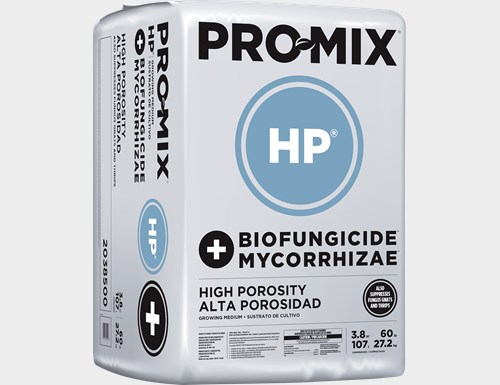
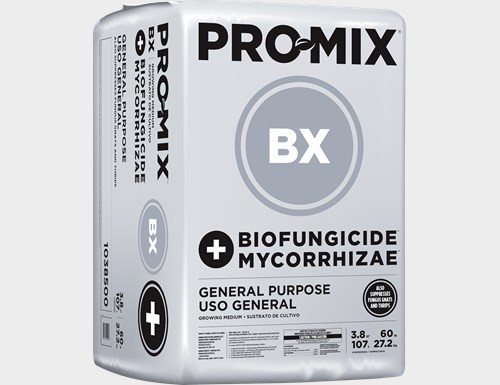
 Where to find our products
Where to find our products
